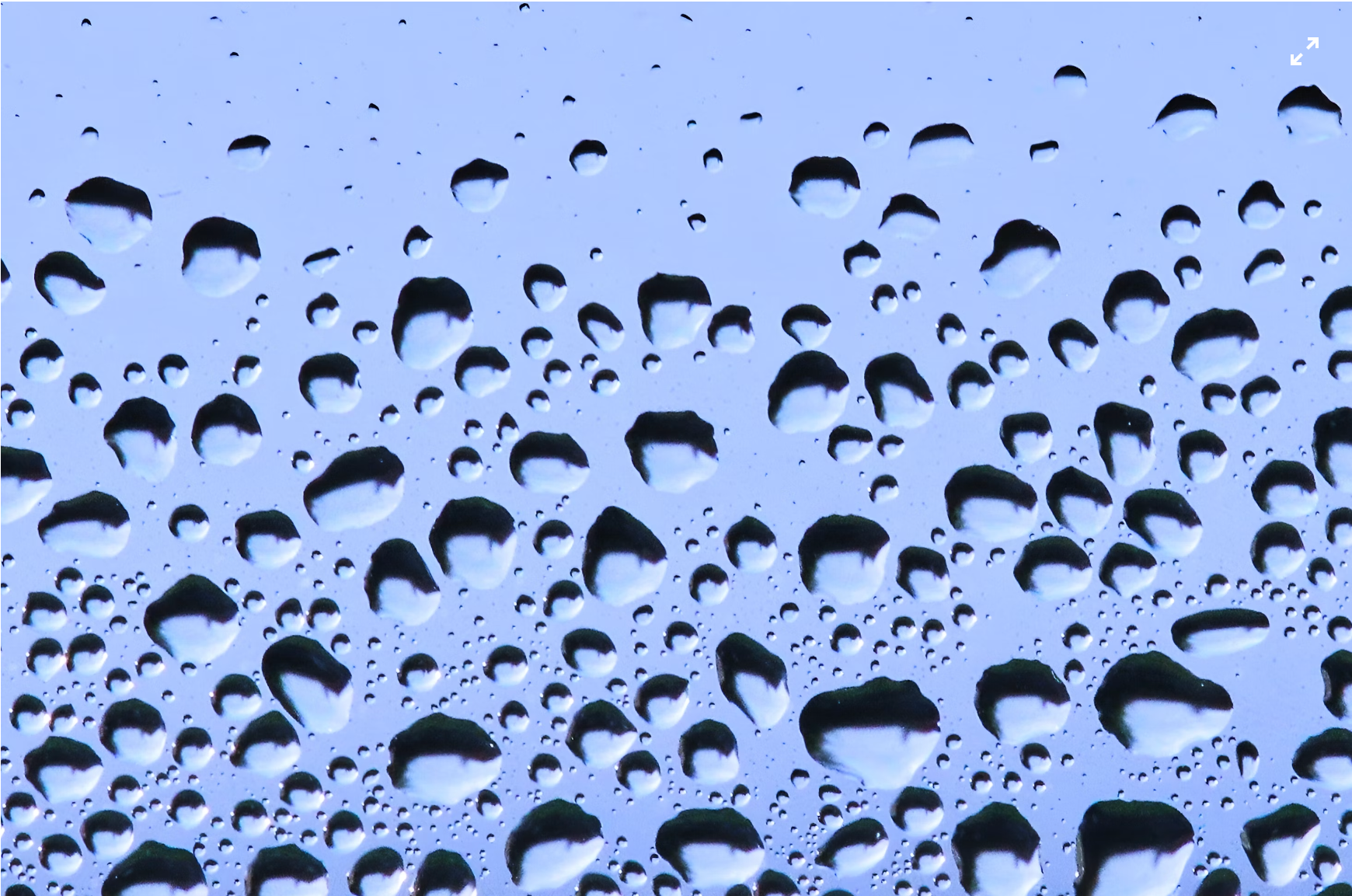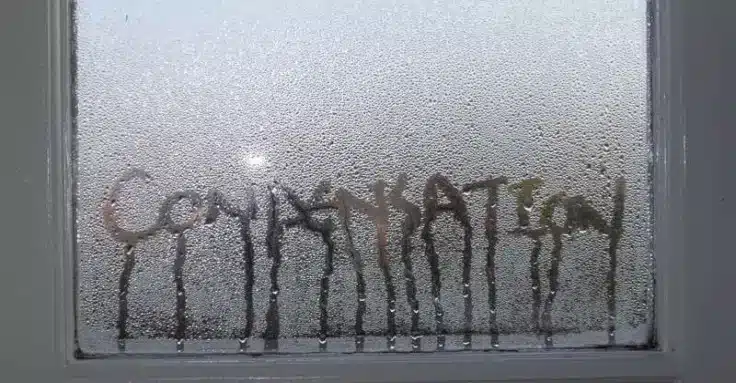Albertan homeowners often notice condensation on their windows, especially in the early mornings or on particularly cold days. While it might seem harmless, excess moisture on windows can lead to other problems, such as mold, poor indoor air quality, and even higher heating bills.
In this ultimate guide, we’ll cover everything you need to know to stop condensation on windows, reduce window condensation, and keep your home comfortable, dry, and energy-efficient.
What Causes Window Condensation?
Condensation forms when warm, moist air inside your home meets a cooler surface, such as a window. The difference in temperature causes moisture in the air to turn into water droplets on the glass.
This is similar to what happens when you take a cold drink outside on a warm day. The colder surface draws moisture from the warmer air, causing condensation on windows.

Key Causes of Window Condensation
- Temperature Difference: When warm air inside your home comes in contact with cold window surfaces, condensation forms. This temperature difference is especially noticeable in the winter, when windows are colder than the air inside your home.
- High Humidity Levels: Interior air filled with moisture-laden air often leads to window condensation, especially when there’s poor air circulation. The higher the humidity, the more moisture will be in the air, increasing the likelihood of condensation on windows.
- Inedequate Insulation: Any cold surface, such as poorly insulated windows or window frames, increases the chances of condensation forming on windows. Cold frames attract moisture, leading to condensation forming on windows.
- Excess Moisture Indoors: Activities like cooking, showering, and drying clothes indoors release excess moisture into the air. This moisture-laden air contributes to window condensation and higher indoor levels of humidity.
Why Window Condensation Matters
If you notice condensation on windows frequently, it’s important to address it. Prolonged exposure to excessive moisture can lead to several issues:
- Mold and Mildew: Excessive humidity provides the ideal conditions for mold to grow. Once this occurs, it can spread quickly and harm the quality of air in your house. Mold can also trigger allergies and other respiratory problems.
- Damage to Windows: Wooden frames absorb moisture, leading to warping, peeling, or rotting over time. This can also affect the structural integrity of your windows.
- Higher Utility Bills: Moisture in the air makes your home feel colder, leading you to turn up the heat. That is why too much moisture and condensation on windows in colder climates like Alberta can majorly contribute to high energy costs.
- Poor Air Quality: High humidity can make breathing more difficult and create an uncomfortable living environment. Keeping indoor air at an optimal humidity level can help improve your air quality and comfort.
How to Stop Condensation on Windows: Key Methods
There are several effective methods to prevent and reduce condensation. With the right steps, you can stop window condensation, protect your home from mold, and maintain a comfortable living space.
Solution 1. Improve Ventilation For Optimal Circulation of Cold and Warm Air
One of the best ways to address condensation on windows is by improving ventilation. Proper air circulation helps move moist air outside and brings in fresh air.
Here is how you can reduce the amount of moist air that can cause condensation to form on cold window panes:
- Open Windows: Whenever possible, open windows to allow fresh air to circulate, especially after cooking or showering. Opening windows allows moisture to escape and prevents condensation from forming on your windows.
- Use Exhaust Fans: Exhaust fans in bathrooms and kitchens help remove excess moisture from the air quickly. They are essential in areas prone to high humidity and moisture buildup. Ensure these fans are operating efficiently.
- Install Ventilation Systems: In homes with inadequate insulation or ventilation, consider adding a whole-house ventilation system to keep the air fresh and reduce moisture. These systems help to improve the quality of air and manage moisture in your home.
Solution 2. Reduce Moist Air and Indoor Humidity Levels
The lower your home’s moisture level, the less likely you are to find condensation on windows. Managing humidity, thus, is crucial for stopping condensation from forming in the first place.
- Use Dehumidifiers: Dehumidifiers effectively remove excess moisture from the air, which helps prevent window condensation. They are especially helpful in areas of your home that tend to get more humid, such as the basement or bathrooms.
- Avoid Indoor Drying: Drying clothes indoors adds to indoor humidity, so try to air-dry laundry outside or use a dryer vented outside. This helps reduce the moisture in the air and prevents excessive condensation on windows.
- Use Moisture Absorbers: Moisture absorbers or silica gel packs can help reduce excess humidity in areas where it tends to collect. These are especially useful in closets or small rooms with little ventilation.
Solution 3. Insulate Windows Properly
Proper insulation can be a game changer for anyone who wants to reduce condensation. Well-insulated windows keep cold air out and prevent warmer air inside from cooling down too quickly. This prevents condensation from forming on colder surfaces.
- Upgrade to Triple-Glazed Windows: Triple-glazed windows have additional layers of insulation, which helps prevent condensation on cold windows. They are highly effective at maintaining a stable indoor temperature and reducing window condensation.
- Check Window Seals: Insufficient insulation around window frames can lead to cooler surfaces that encourage condensation. Ensure window seals are intact and repair any leaks, which can significantly reduce condensation on your windows.
- Add Window Films: Applying an anti-condensation film to windows can reduce moisture buildup by providing an insulating layer. These films help maintain the temperature difference between the inside and outside of your windows.
Solution 4. Manage Indoor Temperature
Temperature consistency helps prevent condensation by reducing the temperature difference between air and windows. Keeping your home at a steady temperature prevents condensation from forming on cold window surfaces.
- Use a Programmable Thermostat.
Set your thermostat to maintain a steady temperature throughout the day, even when you’re not home. This prevents temperature swings that can lead to condensation.
- Keep Room Doors Open.
Allow air to circulate freely throughout your home by keeping interior doors open. This helps avoid cold spots and helps warm air circulate evenly, reducing the chances of condensation on cold windows.
- Balance Heating Sources: Try to distribute heating sources evenly throughout your home to avoid cold spots that can cause condensation. If one area of your home is colder than others, it increases the likelihood of condensation on nearby windows.
Solution 5. Regularly Check Humidity Levels to Avoid Excess Moisture
Tracking your indoor humidity level is crucial in preventing window condensation. If your humidity is too high, condensation will become a common problem.
- Use a Hygrometer: A Hygrometer measures relative humidity in your home. Aim to keep humidity between 30-50% to prevent condensation from forming. A hygrometer is a helpful tool to monitor moisture effectively.
- Adjust as Needed: If moisture levels are above 50%, use a dehumidifier or improve ventilation to reduce excess humidity. This will make a significant difference in reducing window condensation.
- Check Humidity in High-Moisture Rooms: Rooms like bathrooms and kitchens tend to have higher humidity. Be sure to check the moisture levels in these areas regularly and take steps to reduce moisture if necessary.
5 Advanced Tips to Prevent Window Condensation and Excess Moisture
If you’re still noticing condensation on windows, consider trying these additional tips to stop window condensation:
Anti-Condensation Products
Anti-condensation products, such as moisture-absorbing crystals or sprays, can help reduce moisture on windows or frames. These products are designed to keep your windows clear of condensation.
Replace or Upgrade Windows
For older windows that struggle with condensation, upgrading to energy-efficient, double- or triple-glazed windows can be a worthwhile investment. These windows insulate better, reducing condensation on windows and cold surfaces.
Weatherproof Sealing
Make sure windows are well-sealed with weatherproofing materials. This helps keep warm, dry air inside and prevents cold air from reaching indoor surfaces, which helps eliminate window condensation.
Use Window Insulation Kits
This simple solution helps minimize the temperature gap between air at home and window panes, reducing condensation. Such kits are easy to install and can be removed when the warmer weather arrives.
Install a Vapor Barrier
A vapor barrier is a material that prevents moisture from passing through walls, floors, and ceilings, effectively reducing the amount of humid air in your home.
What If My Windows Are Damaged Due to Moist Air and Condensation?
Continuous exposure to moisture can cause issues like mould growth, rotting frames, peeling paint, or even fogging between window panes. If you notice these signs, it’s important to take action to prevent further deterioration and protect the integrity of your windows.
1. Inspect and Assess the Damage
Start by carefully inspecting the affected windows. Look for signs of mold, mildew, or water stains around the window frames. If the window panes have condensation trapped between them, it’s a sign that the seal has failed, which may require professional repair or replacement.
2. Clean and Dry the Area
If there is visible mold or mildew, clean the area immediately with a mixture of water and vinegar or a mild detergent. This helps eliminate harmful spores that can affect the quality if indoor air.Drying the area thoroughly is crucial to prevent mold from returning.
3. Consider Replacing the Windows
If the condensation issue is persistent and caused by damaged seals or poor insulation, replacing the windows may be the best option. Opt for energy-efficient, double or triple-glazed windows to prevent future condensation problems and improve your home’s insulation.
Frequently Asked Questions
In the morning, there is often a significant temperature variation between the cool outdoor air and warm indoor air. This causes condensation, especially if the indoor humidity is high. The cold surface of the window draws moisture from the air, causing condensation to form.
Yes, excessive moisture can damage window frames, lead to mold growth, and even increase your utility bills. That is why you need to eliminate window condensation to safeguard your home and budget in the long run.
While older windows are more prone to condensation due to insufficient insulation, even newer windows can have condensation if the indoor humidity is high or there’s inadequate ventilation.
Yes, inadequate insulation means cold air can get into your home, causing you to turn up the heat to maintain a comfortable indoor temperature. This leads to higher utility costs. Ensuring that windows and doors are properly insulated helps reduce energy costs.
While older windows are more prone to condensation due to insufficient insulation, even newer windows can have condensation if the indoor humidity is high or there’s inadequate ventilation.
Yes, using a humidifier can increase the levels of moisture in your home, which can lead to condensation on your windows. If you use a humidifier, ensure your home is well-ventilated, and use a hygrometer to monitor indoor humidity levels.
Conclusion
Now you know everything on how to stop condensation on windows. Taking the steps outlined above, you can effectively prevent condensation on windows, reduce moisture levels, and improve the quality of indoor air.
Ensuring proper ventilation, insulation, and humidity control will help reduce energy costs and make a significant difference in maintaining a comfortable, energy-efficient home.







 | Website Design Calgary
| Website Design Calgary